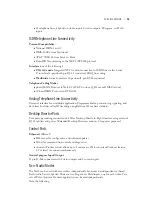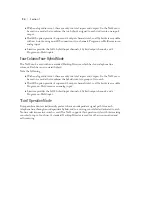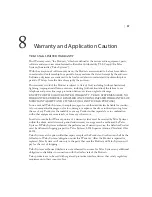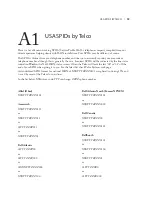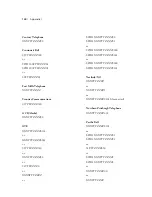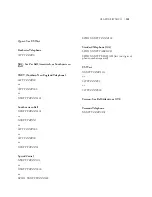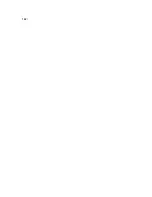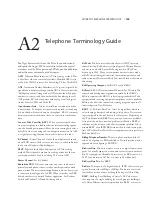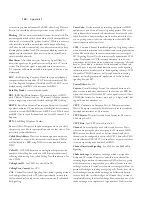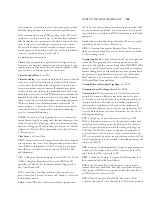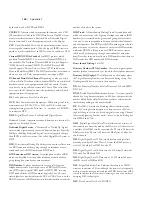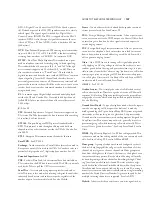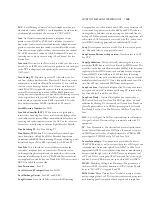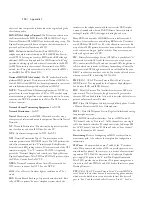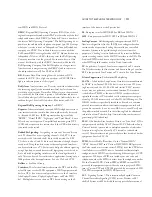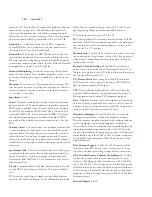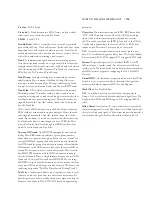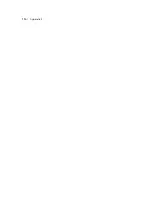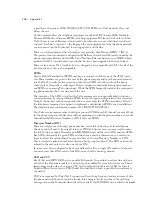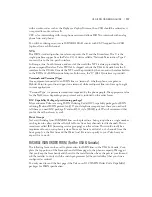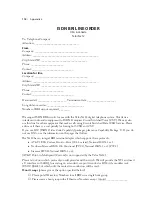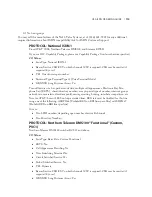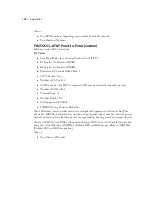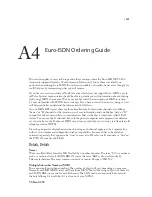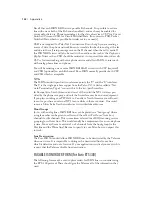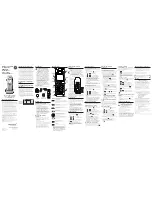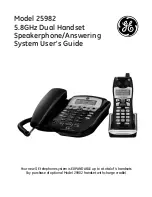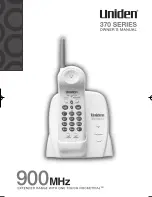
guIde To Telephone TerMInology |
107
Frame
– A unit of data which is defined by the specific communi-
cations protocol used. See Line Format, T1.
FXO
– Foreign Exchange Office termination. A line or port meant
to connect to connect to the POTS output of a Central Office. Such
an interface goes off and on hook to signal status and expects to
receive ringing current.
FXS
– Foreign Exchange Station termination. A line or port mean
to connect to a telephone. Such an interface must look for current
flow to know when the attached device goes off-hook. It must be
able to generate ringing current.
Glare
– On a POTS line an incoming call is signaled by periodi-
cally applying an AC ring voltage to the line. Since there is a semi
random period before the ring, and pauses between rings, it is pos-
sible to seize a line which is “about to ring” (and answer a call) when
attempting to place an outgoing call. When this scenario happens
it is called glare. Glare is much less likely if Ground Start or ISDN
trunks are used. See also Ground Start Trunk.
GR-303
- See SLC-96
Grade of service
- This is simply the ratio of calls blocked to total
calls in a decimal form. Therefore, a grade of service of P.08 would
represent 8% blocking. Telephone tariffs regulate the acceptable av-
erage grade of service which must be provided on public networks.
See also Blocking.
Ground Start Trunk
– A type of telephone trunk where the request
to make an outgoing call (i.e. request for dial tone) is made by
briefly grounding the Tip conductor. Many PBX system use ground
start trunks as they are less prone to glare than Loop start trunks.
Ground start lines are sometimes used with equipment designed for
Loop Start lines. This may or may not work - generally it serves to
prevent outgoing calls while incoming calls work normally. Telcos
may call these “ground start lines”. See Loop Start Trunk. See also
Glare.
HDB3
- High Density Bipolar 3. An E1 line coding method. This
is the more modern line coding method of the two commonly avail-
able. See Line Coding, T1. See also AMI and B8ZS
Hunt group
- A group of telephone channels configured so that if
the first is busy (engaged) the call goes to the next channel, if that
channel is busy it goes to the next channel, etc. Hunt groups may
hunt from the highest to the lowest, the lowest to the highest, or on
some other arbitrary pattern. But the order of hunting will usually
be fixed, beginning with one channel and working through (“hunt-
ing”) until an unused channel is found. The term may have origi-
nated back in the old manual switchboard days when the operator
literally hunted for an unused jack to plug a cord into. This arrange-
ment is very common in business scenarios where a single incoming
number (the Listed Directory Number) is given to the public, but
multiple incoming channels are supported. See also LDN.
Hybrid
– A device which converts from a two-wire signal such as
DSX-1- Digital Cross Connect level 1 (USA & Canada, primar-
ily). Defined as part of the DS1 (T1) specification and is a closely
related signal. The type of signal switched by a Digital Cross-
Connect System (DACS). The FDL is stripped off at the DACS
interface. DSX-1 is also the type of signal that arrives at the user
side of a CSU on a T1 line. A DSX-1 cable is limited to 655 feet
(200 meters).
DTE
- Data Terminal Equipment- When using serial communica-
tions such RS-232, V.35, or X.21, the DTE is the device sending/
receiving from a modem or CSU/DSU. In contrast to DCE.
DTMF
– Dual Tone Multi Frequency. The standard tone-pairs
used on telephone terminals for dialing using in-band signaling.
The standards define 16 tone-pairs (0-9, #, * and A-F) although
most terminals support only 12 of them (0-9, * and #). These are
also sometimes referred to as “Touch Tones”. Note that while
digital data terminals have the same symbols, ISDN uses “common
channel signaling” (over the D channel) and therefore does not
necessarily generate any tones at all. However many terminals still
generate the tones since they will still be used on occasion to access
services (such as voicemail or automated attendant) at the far end
using in-band tones.
E1
- A common type of digital telephone trunk widely deployed
outside the US and Canada. Has 31 available 64 kbps channels
(called DS0s) plus a sync/control channel for a total data rate of
2.048 mbps.
E-1
- See E1
ESF
- Extended Superframe. A type of Line format supported on
T1 circuits. The Telco determines the line format and line encoding
of your line. See Line Format.
ETS 300
- The pan-European ISDN protocol standardized by
ETSI. This protocol is used throughout Europe and has been
adopted in many other countries outside the USA & Canada. See
also MSN.
ETSI
- European Telecommunications Standards Institute
Euro ISDN
- See ETS 300.
Exchange
- Another name for a Central Office (most often used in
European countries). Also used in the USA & Canada to refer to a
particular 3-digit prefix of a 7-digit telephone number. See CO.
Extended Superframe
. See ESF.
FDL
- Facilities Data Link. A bi-directional data link available on
T1 circuits when the ESF line format is used. The FDL is primarily
used by the Telco to poll the CSU for error statistics.
Four Wire
– A circuit path using separate pairs for send and re-
ceive. This term is also used when referring to digital channels that
inherently have discrete send and receive paths, regardless of the
number of pairs (or other media) used. See also Hybrid.
Summary of Contents for Nx12
Page 4: ......
Page 42: ...32...
Page 100: ...90 Section 6...
Page 105: ...Specifications 95...
Page 106: ...96...
Page 108: ...98...
Page 112: ...102...
Page 124: ...114 Appendix 2...

